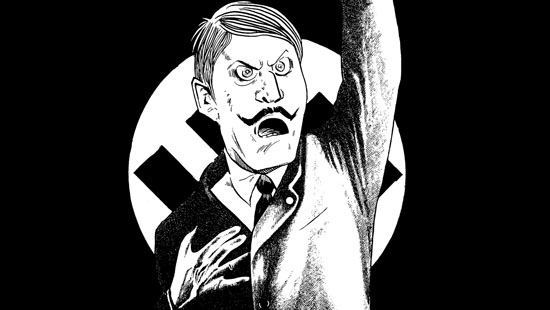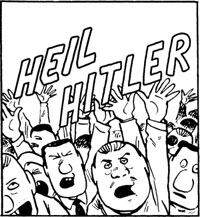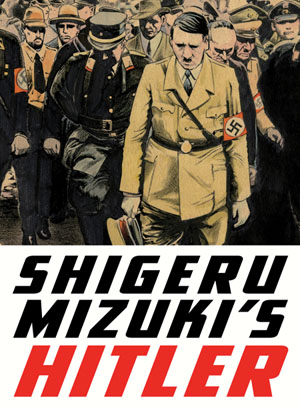 Artwork from SHIGERU MIZUKI’S HITLER is copyright Mizuki Productions, and provided courtesy of Drawn & Quarterly.
Artwork from SHIGERU MIZUKI’S HITLER is copyright Mizuki Productions, and provided courtesy of Drawn & Quarterly.Shigeru Mizuki is one of the most magical manga artists: sometimes scary, sometimes wryly funny, always human and humane. Drawn & Quarterly has been doing the Lord’s own work by publishing Mizuki’s manga in the U.S., from his beloved children’s horror manga Kitaro to his autobiographical comics set on the front lines of World War II. Justly revered in Japan, Mizuki is a treasure.
Hitler is the first Mizuki manga that underwhelms me. It seems like a concept that can’t fail: the thoughtful, pacifist World War II veteran, who depicted the cruelty and absurdity of his own country’s military in books like Onward Toward Our Noble Deaths, tackling Adolf Hitler himself in a well-researched biography. The one-volume graphic novel starts with promise, showing the dictator at the height of his power before flashing back to his early days as a struggling art student with a hot temper. In a shockingly short time, the young Hitler transitions from directionless artist to patriotic soldier to xenophobic rabble-rouser who seizes control of a fringe political party and turns it into a juggernaut. He even steals the idea for his mustache.
As political maneuvering moves to the forefront, however, Mizuki loses his grip on the narrative and, perhaps, his interest. He starts to tell rather than show, skipping over major events with cramped blocks of text. Even as war rages, the artwork consists mostly of hastily drawn talking heads.  The story fragments; we see Eva Braun twice, once meeting Hitler and once dying with him in a bunker, with no explanation as to what happened in between. (Mizuki does a better job outlining Hitler’s earlier creepy relationship with his teenage niece Geli.) The Holocaust and other Nazi atrocities are only sporadically mentioned, as if Mizuki keeps forgetting them. Mizuki excels at recounting Hitler’s eccentricities and drawing his own versions of iconic photographs and paintings but seems less enthusiastic when it comes to explaining what Hitler actually did to become so powerful and so notorious.
The story fragments; we see Eva Braun twice, once meeting Hitler and once dying with him in a bunker, with no explanation as to what happened in between. (Mizuki does a better job outlining Hitler’s earlier creepy relationship with his teenage niece Geli.) The Holocaust and other Nazi atrocities are only sporadically mentioned, as if Mizuki keeps forgetting them. Mizuki excels at recounting Hitler’s eccentricities and drawing his own versions of iconic photographs and paintings but seems less enthusiastic when it comes to explaining what Hitler actually did to become so powerful and so notorious.
Maybe Mizuki was intrigued by the idea of drawing Hitler’s biography but found the task unpleasant when he put pen to paper. It’s certainly not a cheerful story. A great graphic novel about the most reviled figure of the 20th century is certainly possible, but Mizuki’s Hitler isn’t it.



![SSSS.Dynazenon [Anime Review] SSSS.Dynazenon [Anime Review]](https://otakuusamagazine.com/wp-content/uploads/2021/08/16-9-SSSS.Dynazenon_Key_Visual_3.5-480x360.jpg)
![Back Arrow [Anime Review] Back Arrow [Anime Review]](https://otakuusamagazine.com/wp-content/uploads/2021/07/ba15-02686-480x360.jpg)
![Dawn of the Witch [Manga Review] Dawn of the Witch [Manga Review]](https://otakuusamagazine.com/wp-content/uploads/2021/07/16-9-DawnoftheWitch-cvr_02-480x360.jpg)
![Nina The Starry Bride [Manga Review] Nina The Starry Bride [Manga Review]](https://otakuusamagazine.com/wp-content/uploads/2021/07/nina-the-starry-bride-v1-16-9-480x360.jpg)
![Sleepy Princess in the Demon Castle [Anime Review] Sleepy Princess in the Demon Castle [Anime Review]](https://otakuusamagazine.com/wp-content/uploads/2021/02/Maoujou-de-Oyasumi-ED-Large-06-480x360.jpg)